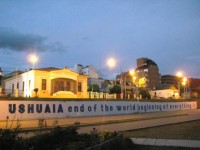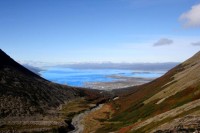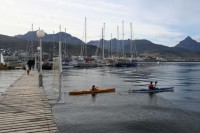Tue 8 Apr 2008
The End of the World
Posted by Shanna under Argentina
No Comments
Before we arrived in Ushuaia, Argentina, I knew only that it was the southernmost city on earth–literally, the end of the world–and that Argentine prisoners had once been sent there to maintain Argentina’s hold on the land (presumably because no one else was willing to go). The place didn’t sound particularly promising…

But the town has come a long way since the prison was established in 1896. More than 100 years later, it’s transformed into both a place where Argentinians move to raise their families ((Two decades ago, it had the highest population growth rate in the world!)) and a destination that is fairly popular among tourists. Travelers who come to Ushuaia (most of whom are either backpackers or soon-to-be passengers on one of the cruise ships that docks in the local marina) will find plenty to keep them busy and well fed for a few days. A quick culinary note: Ushuaia is famous for its king crab, or “centolla.” Those who know me well are aware of my desperate love for crab. It’s hard to adequately describe the happiness I felt upon being presented with a heaping plate of the stuff, steamed and already shelled.

Just five minutes outside the city waits Glaciar Martial, which is essentially a moderately sized, glacier-topped mountain with a sometimes-functional chairlift. (It’s used for skiing during the winter.) On the day that we chose to climb it, the chairlift was out of commission. (Unlike when we climbed Volcano Villaricca, however, the malfunction didn’t launch us into despair… It simply meant a brief extension of a pleasantly steep hike.) The climb itself was spectacular, in part because it allowed for stunning views of the mountain-flanked Beagle Channel that improved with every upward step. The thing that really amazed us about the hike, though, was that it was just one of many options located within a few minutes of Ushuaia. The proprietor of our hotel described it to us as “ok.” Ok?? If this hike were located anywhere in the U.S., we’re certain that–with its fantastic views of mountains, water and a glacier alike–it’d be one of the best around.

Given Ushuaia’s former status as a penal colony, we felt it necessary to pay a visit to the place where some 600 unfortunate souls found themselves incarcerated. Now titled the “maritime museum,” the prison houses everything from balsa wood models of ships to department store dummies dressed as prisoners to two art galleries, one with a nautical theme, the other best described us “the paintings that likely hung in your hair salon at some point in the early 90s.” (Think lots of teal and turquoise…) Some of the cells are open to tourists; they provide a glimpse of just how cold and lonely it must have been to be imprisoned at the end of the world.
[embedplusvideo height=”350″ width=”450″ editlink=”http://bit.ly/1mFIYzV” standard=”http://www.youtube.com/v/Y9maR2-Jqss?fs=1″ vars=”ytid=Y9maR2-Jqss&width=450&height=350&start=&stop=&rs=w&hd=0&autoplay=0&react=1&chapters=¬es=” id=”ep3171″ /]
No Responses to “ The End of the World ”